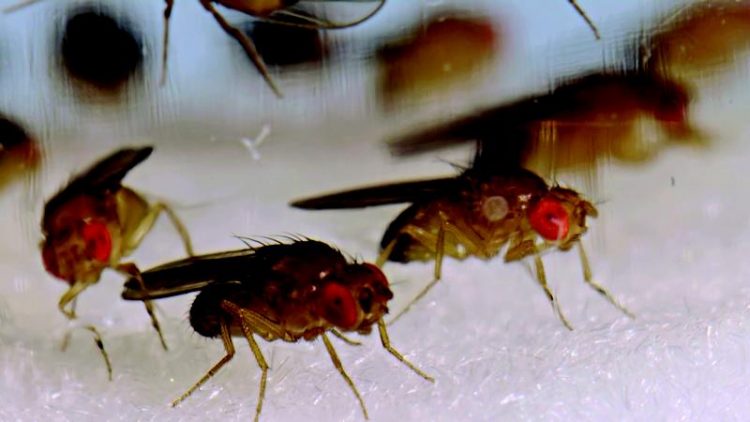New genes on “deteriorating” Y chromosome

The Y-chromosome of fruit flies consists not just of "gene-junk", but also functioning genes. Markus Riedl
Y chromosomes, which are only inherited paternally, evolved from “normal” chromosomes known as autosomes. As males only possess one Y chromosome, there is no counterpart for recombination, the direct exchange of genetic material. This makes the deletion of harmful mutations on the Y chromosome more difficult than in other chromosomes.
As a result, genes on the Y chromosome usually undergo a process of degeneration. Earlier studies with fruit flies have shown that new genes can be transferred onto the Y chromosome, although the rate was estimated as very low (1 transfer in 10 million years).
Researchers from the Institute of Population Genetics at Vetmeduni Vienna, using a new and highly specific analysis method, could now provide fresh momentum to help decode the evolutionary dynamics of the Y chromosome. Their study shows that ten times more new genes are transferred onto the Y chromosome in fruit flies than had been previously thought. Some of these new genes even appear to have taken on important functions.
New method brings momentum to the previously difficult identification of Y-linked genes
The Y chromosome has been a tough nut to crack in genome research. As it possesses only few functional genes, and these are embedded in repetitive DNA that is difficult to analyse, finding these genes is a challenge. “Only seven functional genes have been identified on the Y chromosome of Drosophila melanogaster. But we suspect that the number of functional genes as well as the actual transfer rate must be higher,” says first author Ray Tobler.
“We therefore developed a new analysis method that allows us to efficiently search for gene transfers onto the Y chromosome, so-called GeTYs.”
The researchers’ trick consisted in sequencing the genome of males and females from a so-called inbred strain of fruit flies. These differ only in the Y chromosome sequence. “The key to our results was to search for variants in the males that do not exist among the females,” says Tobler.
“That means we worked without any known Y chromosome sequences that would usually be used for a comparison. This allowed us to trace the transferred genes back to so-called retrocopies, which are created when the RNA transcript of a gene is inserted into the Y chromosome.”
Transferred RNA copies and important selection mechanisms identified for the first time
All previously described gene transfers onto the Y chromosome involved the transfer of a piece of the chromosome and not an RNA transcript. “The high number of validated gene transfers allowed us to statistically show that there were differences between Drosophila species,” explains senior author Christian Schlötterer. “We only found genes originating from an RNA transcript in the closely related D. mauritiana and D. simulans, which suggests that the transfer mechanisms are species-specific.”
New impetus for Y chromosome research in other species
A special surprise for the research team was that four of the 25 newly transferred genes on the Y chromosome have already assumed an important function there. “As these new genes can be found in all individuals of a species, the question arises as to which functions these new Y-linked genes could have,” says Tobler. Until now, it has been still completely unclear if and how long these new genes can withstand the deterioration of the Y chromosome. As the new analysis method does not require a reference genome for the Y chromosome, it offers enormous potential to study the dynamics of new genes on the Y chromosome in many different species. “I expect many more exciting findings,” concludes Christian Schlötterer.
Service:
The article “High rate of translocation-based gene birth on the Drosophila Y chromosom“ by Ray Tobler, Viola Nolte and Christian Schlötterer was published in PNAS.
http://www.pnas.org/content/early/2017/10/18/1706502114.full
About the University of Veterinary Medicine, Vienna
The University of Veterinary Medicine, Vienna in Austria is one of the leading academic and research institutions in the field of Veterinary Sciences in Europe. About 1,300 employees and 2,300 students work on the campus in the north of Vienna which also houses five university clinics and various research sites. Outside of Vienna the university operates Teaching and Research Farms. The Vetmeduni Vienna plays in the global top league: in 2017, it occupies the excellent place 8 in the world-wide Shanghai University veterinary in the subject “Veterinary Science”. http://www.vetmeduni.ac.at
Scientific Contact:
Christian Schlötterer
Institute of Population Genetics
University of Veterinary Medicine Vienna (Vetmeduni Vienna)
T +43 1 25077-4300
christian.schloetterer@vetmeduni.ac.at
Released by:
Georg Mair
Science Communication / Corporate Communications
University of Veterinary Medicine Vienna (Vetmeduni Vienna)
T +43 1 25077-1165
georg.mair@vetmeduni.ac.at
http://www.vetmeduni.ac.at/en/infoservice/presseinformation/press-releases-2017/…
Media Contact
All latest news from the category: Life Sciences and Chemistry
Articles and reports from the Life Sciences and chemistry area deal with applied and basic research into modern biology, chemistry and human medicine.
Valuable information can be found on a range of life sciences fields including bacteriology, biochemistry, bionics, bioinformatics, biophysics, biotechnology, genetics, geobotany, human biology, marine biology, microbiology, molecular biology, cellular biology, zoology, bioinorganic chemistry, microchemistry and environmental chemistry.
Newest articles

Hyperspectral imaging lidar system achieves remote plastic identification
New technology could remotely identify various types of plastics, offering a valuable tool for future monitoring and analysis of oceanic plastic pollution. Researchers have developed a new hyperspectral Raman imaging…

SwRI awarded $26 million to develop NOAA magnetometers
SW-MAG data will help NOAA predict, mitigate the effects of space weather. NASA and the National Oceanic and Atmospheric Administration (NOAA) recently awarded Southwest Research Institute a $26 million contract…

Protein that helps cancer cells dodge CAR T cell therapy
Discovery could lead to new treatments for blood cancer patients currently facing limited options. Scientists at City of Hope®, one of the largest and most advanced cancer research and treatment…



